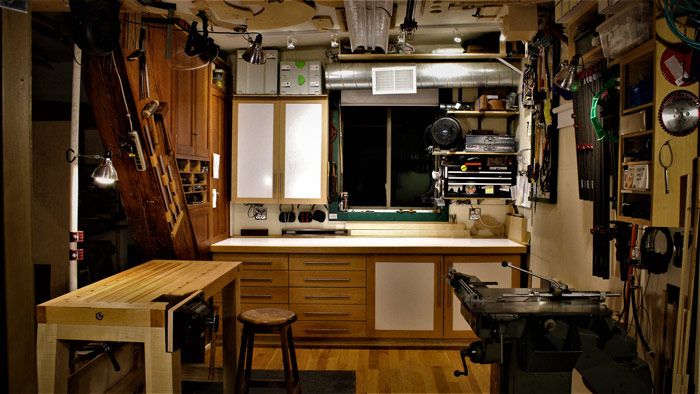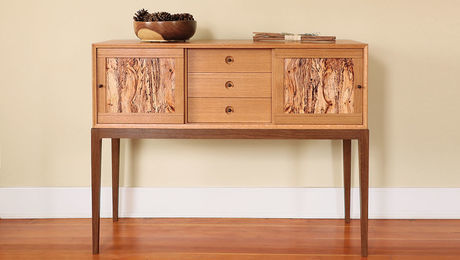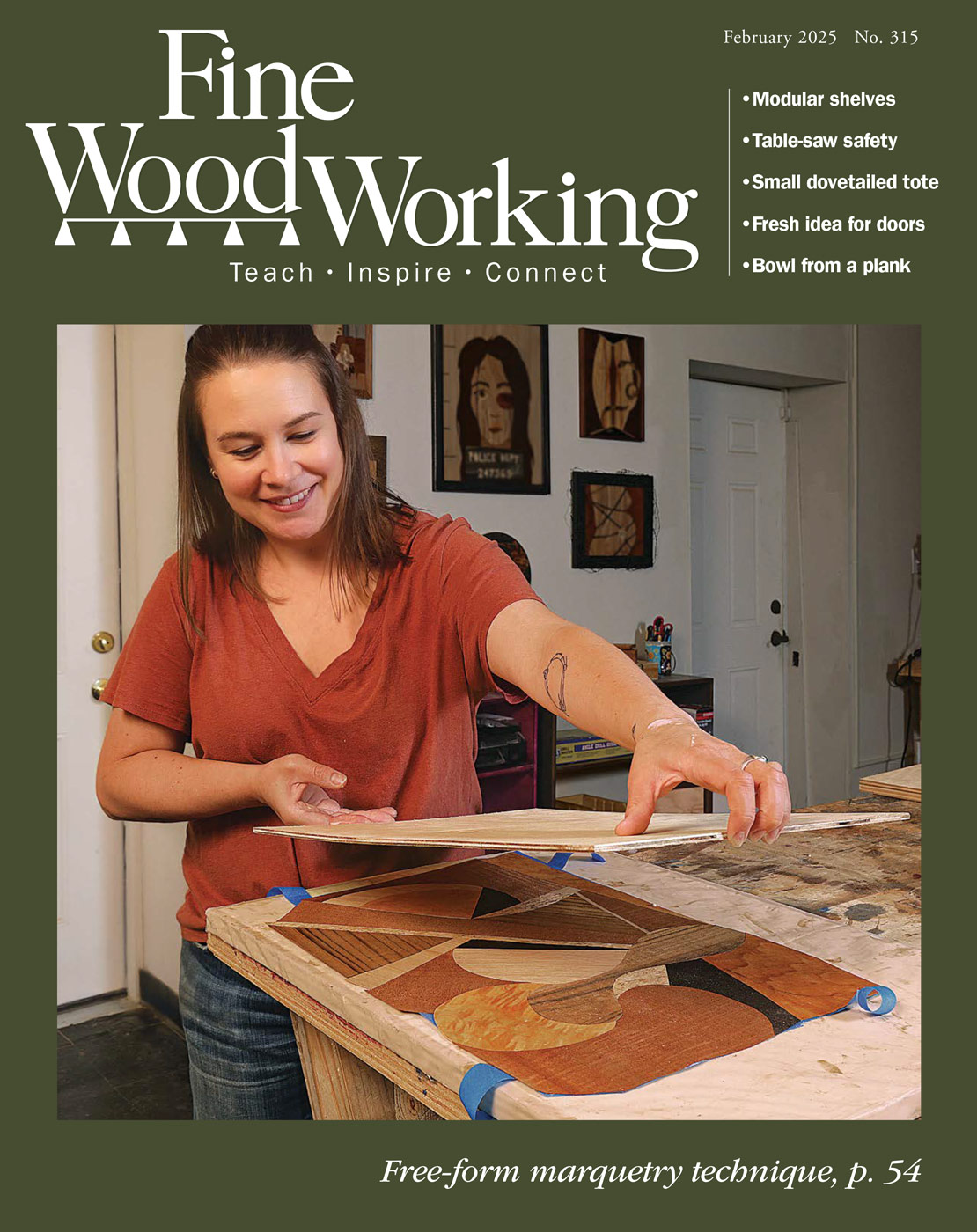The importance of working clean
Bob Miller shares lessons from a 108-sq.-ft. bench space
My personal bench space is a mere 108 sq. ft. with access to a larger shared machine room. Given that I have such limited space to call my own, I have to work clean. And given the frantic flurry of cleaning going on in the world right now, this is a great time to talk about working clean in the shop.
Working clean centers around thinking through your processes and working habits and then adapting your space and daily habits to match. The goal is that a tool can be close at hand while working on a project but still out of the way when it is not needed. This also includes taking the time to clean the shop in between steps in the process to keep ahead of the mess, because making a mess is inevitable in our line of work.
If you take the time to work clean at every step of the process, you’ll actually work faster in the long run. And you’ll be able to work on larger projects out of a smaller space. With my 108 sq. ft. of bench space, every inch counts and everything must have a place. The idea that adding the steps of cleaning and organization would actually speed you up may seem counterintuitive, but hear me out.
When you work clean, you don’t have to stop to find a tool that was left out on the bench, then covered up and hidden in the next step. You don’t have to worry about losing a critical small part in the clutter that gathers as the process builds. By following these simple steps it is possible to maximize any work space from the smallest of areas to the largest of shops.
To start your journey into working clean, the first step is simply to clean, apart from any particular project or process. Simply put everything where it is supposed to be, and from there assess what is where, and whether everything has a place. A great way to remind yourself that space in the shop is precious is to do some quick math. First you need to know the total space of your shop; next you need a rough number for how much your shop costs per month. For those of us who rent space, this is an easier number; for those who have basement or garage shops it can be a bit more nebulous, but take a whack at it anyway. With these two figures you can find out how much in terms of dollars per space it costs for everything in your shop simply to exist. For example, my trash can costs me $7.75 a month in floor space. Armed with the knowledge, I can make informed decisions as to the value of any object I wish to keep in the space—and I have decided that having a trash can next to my bench is worth it.
This newfound knowledge of value for space can also illuminate the enemy that is scrap. Scrap is a real and insidious enemy; it lurks in the shadows and builds a small army in the darkness at the edge of the shop. DON’T LET IT! Get in there and make the tough call to let it go. Now that you know exactly how much your space costs sitting empty, it is possible to calculate how long it will be before the cost of the lost space is greater than the cost of those scraps of wood.
The next step in working clean is often the hardest, yet seems the simplest. Put away each and every tool at the end of a process. If you do this, you will know for certain where everything is and you will not waste time looking for something that has gone rogue. This will also keep your precious working space open for the task at hand, and it will pay off because you won’t leave tools in your own way. This practice has the side benefit of protecting your tools—particularly edge tools—from accidental damage when they get pushed off the edge of the bench or crashed into another tool. (I once lost a handplane this way. It was pushed to the corner of my bench and, while working on something totally unrelated, I pushed a scrap across the bench and a chain reaction of clutter pushed the plane right onto the floor, damaging it beyond repair!)
Finally the last benefit of working clean is not necessarily technical but more philosophical. Cleaning the shop is akin to raking a zen garden: Shut out the troubles of the world and focus on the shop. I often find the best clarity of ideas and process come to me not when I am stressed over how something is supposed to look but rather during the simple act of cleaning.
I hope that you will give working clean a try and hopefully you will see some of the benefits and joys that I have seen.
 |
|
 |
Hand tools are kept close at hand with hanging panelsby Jason Stephens |

















Comments
I found this blog comforting. I have a pretty clean shop. It's small enough that it becomes unusable if it's a mess. Sometimes I get frustrated stopping to clean up between tasks, like it's a shortcoming! Turns out it's just about the only way.
As my workspace is in the garage I've noticed that as the space gets more cluttered it quickly becomes a dumping ground for the rest of the family as they pass through to the house. It's much easier to get others to take care of their coolers, beach toys, yard sale finds, junk mail, etc. when it's not mixed in with my own clutter. I've had to spend the last 2 weekends getting my space back to a usable level, some of the cleanout involved boxes and bins that got left in the space when we moved in 3 years ago and never made it to their final destination.
My work routine is pretty much as you described, when I finish a process I put my tools away. It definitely removes the inevitable stress that comes with working in a "messy" environment but for me it serves another purpose as well. It slows me down. I tend to get tunnel vision when I work and that causes me to accelerate my work process and lose sight of the big picture. Stopping and cleaning up lets me re-focus on the work flow in a more logical, unhurried manor. I enjoyed the article, thank you.
I work along one and a half walls in the garage and have some shelving. When the car is pulled out, I probably have about the same amt of space. I keep the shop tidy. Much of what is in these tips is what I have done to keep things tidy.
As for scrap wood, I allow myself two 5 gallon buckets. When they are full, new pieces that go in must result in one being tossed. Every few years, I make a major culling of these two buckets. The culled wood then is often used as BBQ wood. Nothing like BBQing a steak over a nice coal bed from cherry or walnut.
And yes, I have had times where I have had to go buy a piece of wood because I tossed a piece of scrap that would have worked.
As for my dad, he has trouble getting rid of anything (he has three extra blenders in the attic, because, well, you never know when the blender in the kitchen which gets used once a year at most may fail). The way I have tried to point out cost to him is that if reduced clutter in his garage (it is big, huge actually) he could fit two more cars in it. He states, I don't have two more cars. To which I say you are right. The going rate for garage space is $300/month per car if you were to rent it. He could be making $600 a month, 7 grand a year. The clutter stuff isn't worth that much money. As such, his clutter is costing him 7 grand a year in lost rental space AND he knows folks he wouldn't being in his shop who would be happy to rent the space to park a car there..
My shop is one half of a two-car garage, 280-300 sf. I'm naturally a neat worker. All these admonitions to put the tools away after each use. MY god, I thought, some people don't do that? That would drive me nuts. I even sweep the floor (which is my final clean-up step) when I break for lunch. The organization makes it a pleasant space to work, and to think.
The shop is informally split in half: Hand tools, 500 lb workbench, 300 lb hanging tool cabinet, etc. all toward the back, and the door to the house. Milling machinery, sanders, etc. are all to the front, some up against the overhead door 'wall'. I've arranged the stationary machines so I can lift the overhead door and get plenty of outfeed space. Also, the messier, noisier work is further from the inside door to the house.
My main challenges are simply needing more space (dust collection, drum sander...), managing scraps (I don't like to throw away perfectly good material), and dust collection (see 'more space').
Also, and at odds with the 'space' issue, because wall storage is at a premium... I wish for more natural lighting.
But overall, my shop is a comfortable and productive place.
Very good article
Log in or create an account to post a comment.
Sign up Log in